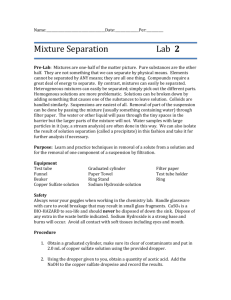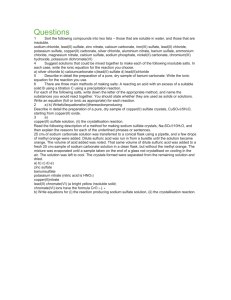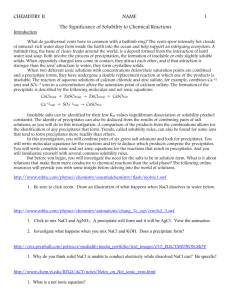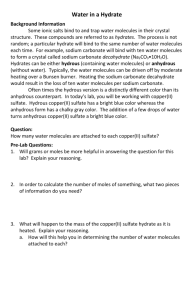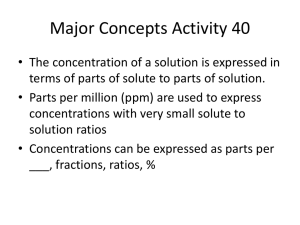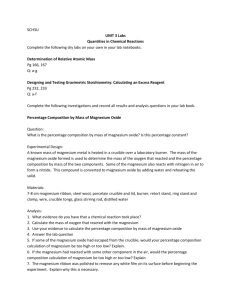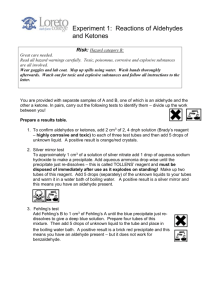Click www.ondix.com to visit our student-to
advertisement
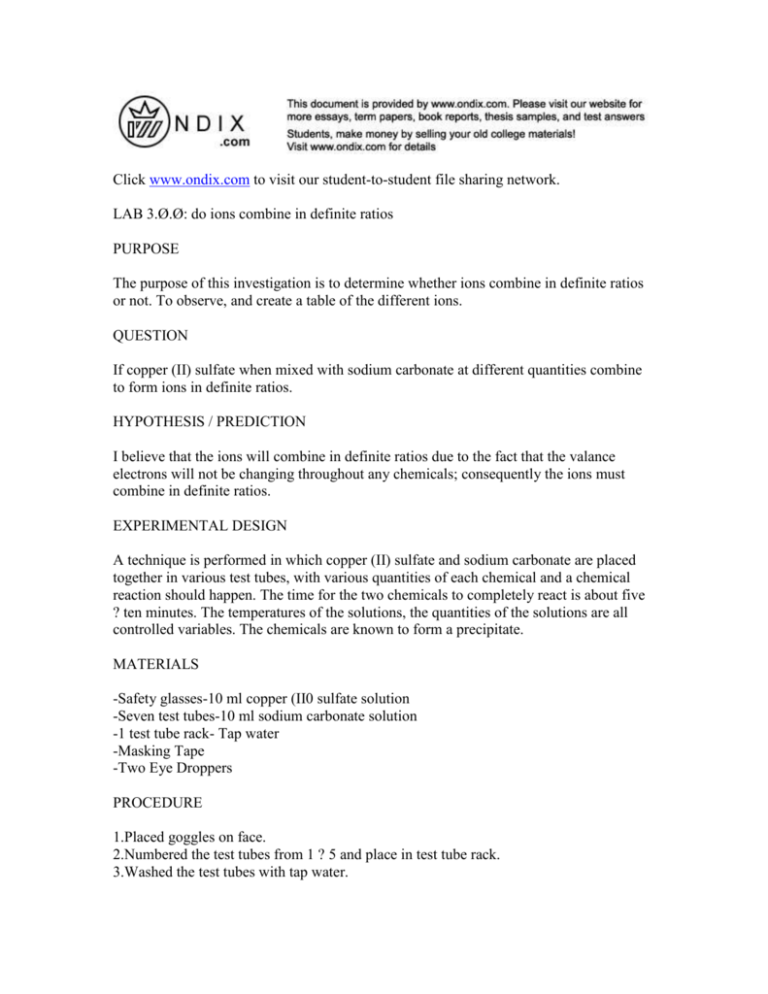
Click www.ondix.com to visit our student-to-student file sharing network. LAB 3.Ø.Ø: do ions combine in definite ratios PURPOSE The purpose of this investigation is to determine whether ions combine in definite ratios or not. To observe, and create a table of the different ions. QUESTION If copper (II) sulfate when mixed with sodium carbonate at different quantities combine to form ions in definite ratios. HYPOTHESIS / PREDICTION I believe that the ions will combine in definite ratios due to the fact that the valance electrons will not be changing throughout any chemicals; consequently the ions must combine in definite ratios. EXPERIMENTAL DESIGN A technique is performed in which copper (II) sulfate and sodium carbonate are placed together in various test tubes, with various quantities of each chemical and a chemical reaction should happen. The time for the two chemicals to completely react is about five ? ten minutes. The temperatures of the solutions, the quantities of the solutions are all controlled variables. The chemicals are known to form a precipitate. MATERIALS -Safety glasses-10 ml copper (II0 sulfate solution -Seven test tubes-10 ml sodium carbonate solution -1 test tube rack- Tap water -Masking Tape -Two Eye Droppers PROCEDURE 1.Placed goggles on face. 2.Numbered the test tubes from 1 ? 5 and place in test tube rack. 3.Washed the test tubes with tap water. 4.Using the eyedropper, added the appropriate number of copper (II) sulfate to the numbered test tube. 5.Using the second eyedropper, added the appropriate number of sodium carbonate to the numbered test tubes. 6.Swirled test tubes gently to mix the contents. 7.Allowed the precipitate to settle for 7 minutes. 8.Recorded observations. OBSERVATIONS Table 1.1 Test Tube #(Column 1) Copper (II) Sulfate Drops (column2) Sodium Carbonate Drops (Column 3) General Observations- ColourPrecipitate (column4) 119Light BlueLittle 237Medium BlueMedium 355Dark BlueLarge 473Medium BlueMedium 591Light BlueLittle Double Displacement: CuSO4 (aq) + NaCO3 (aq) à CuCo3(s) + NaSO4 (aq) ANALYSIS 1.2 Test Tube #: 1 2 3 4 5 Copper (II) Sulfate Drops: 1 3 5 7 9 Sodium Carbonate Drops: 9 7 5 3 1 Ratio of Cu 2+ ions to CO3 2-ions:1:9 3:7 5:5 7:3 9:1 1.The reaction that occurred in the experiment was a chemical reaction, double displacement-precipitate reaction. The Copper reacted with the carbonate and form the precipitate, while the Sodium and Sulfate was the ?clear? part in the test tube. CuSO4 (aq) + NaCO3 (aq) à CuCo3(s) + NaSO4 (aq) 2.Refer to table 1.2 3.The test tube that contains the most precipitate is #3. This one has the most because of the ratio of Cu to CO3 ions (1:1); therefore the Copper can react equally with the carbonate and the Sodium with the Sulfate. I can conclude then that the close the ratio is the more precipitate will be present. 4.Test tubes #1 and #5 contain the least precipitate because the ratios are the largest, (1:9 , 9:1). Both test tubes produced the same amount of precipitate though. Since the ratios are large that means that one chemical will only have a small amount to react with the other chemical. I can establish that opposite ratios will have the same amount of precipitate. 5.This evidence suggests that ions combine in definite proportions because whenever a large amount of the copper (II) sulfate was added to a smaller amount of the sodium carbonate a small amount of precipitate was produced. Also whenever a small amount of copper (II) sulfate was added to a larger amount of sodium carbonate, still a small amount of precipitate was formed. Therefore ? Furthermore ions do combine in definite ratios because of the valance electrons. Each chemical has a certain amount of valence electrons, so when another chemical comes to form a molecular bond it must occupy the remaining area of the shell to become stable. No matter what the chemical will always have the same amount of valence electrons, as a result always combining in definite proportions. CONCLUSION Therefore by adding the appropriate amounts of copper (II) sulfate and sodium carbonate together a chemical reaction occurred and a precipitate was formed. The precipitate was the CuCo3(s) and was formed at the bottom of the test tube while the clear ?liquid? was the NaSO4 (aq) , which formed at the top. A double displacement occurred, CuSO4 (aq) + NaCO3 (aq) à CuCo3(s) + NaSO4 (aq). Through table 1.1 and 1.2 several distinct patterns are shown. The test tubes with opposite ratios (ex: Test tube 1 and test tube 5) have the same amount of precipitate and colour because there is only so much of one substance that can react with the other. Therefore test tube 3, which had a ratio of 1:1 had the most precipitate, in view of the fact that there was an equal amount of each substance that could react with each other. The closer the ratio, the more precipitate. In addition the test tubes with the larger ratios were found to have a light colour of blue, while the test tubes with the smaller ratios achieved a darker blue. The hypothesis was correct in saying that the ions would combine in definite ratios even though the experiment did not prove that it did due to the valence electrons. The ?valence electron theory? is the theoretical explanation in which in cannot be observed. For those reasons one can conclude that ions do combine in definite ratios. Keywords: ions combine definite ratios purpose purpose this investigation determine whether ions combine definite ratios observe create table different ions question copper sulfate when mixed with sodium carbonate different quantities combine form definite ratios hypothesis prediction believe that will fact that valance electrons will changing throughout chemicals consequently must experimental design technique performed which copper sulfate sodium carbonate placed together various test tubes with various quantities each chemical chemical reaction should happen time chemicals completely react about five minutes temperatures solutions quantities solutions controlled variables chemicals known form precipitate materials safety glasses copper sulfate solution seven test tubes sodium carbonate solution test tube rack water masking tape droppers procedure placed goggles face numbered tubes from place tube rack washed with water using eyedropper added appropriate number numbered tube using second eyedropper added appropriate number numbered swirled gently contents allowed precipitate settle minutes recorded observations observations table column drops column drops column general observations colourprecipitate light bluelittle medium bluemedium dark bluelarge medium bluemedium light bluelittle double displacement cuso naco cuco naso analysis drops ratio reaction that occurred experiment chemical reaction double displacement precipitate reacted form while clear part cuso naco cuco naso refer table contains most this most because ratio therefore react equally conclude then close ratio more will present contain least because largest both produced same amount though since large means only have small amount react other establish opposite have same amount this evidence suggests proportions because whenever large added smaller small produced also whenever small larger still formed therefore furthermore valance electrons each certain valence electrons when another comes molecular bond must occupy remaining area shell become stable matter what always have same valence result always combining proportions conclusion therefore adding appropriate amounts together occurred formed cuco formed bottom while clear liquid naso which double displacement occurred cuso naco through several distinct patterns shown opposite colour there only much substance other which most view fact there equal each substance could other closer more addition larger were found light colour blue while smaller achieved darker blue hypothesis correct saying would even though experiment prove valence electron theory theoretical explanation cannot observed those reasons conclude Keywords General: Essay, essays, termpaper, term paper, termpapers, term papers, book reports, study, college, thesis, dessertation, test answers, free research, book research, study help, download essay, download term papers

